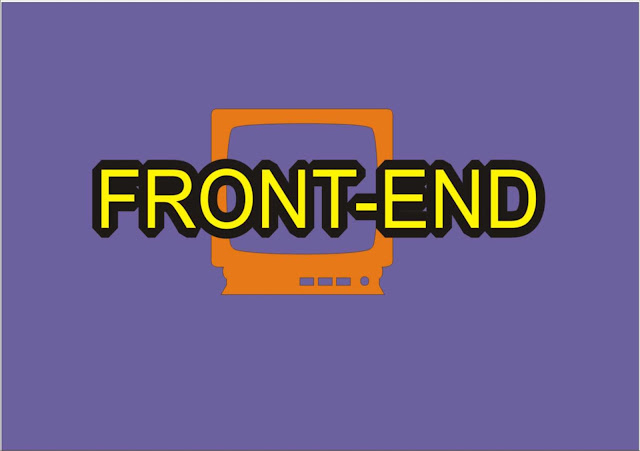Hello
this article is meeting you in a good and well situation. Today we’re going to
remind our self different between Front-end and Back-end Developer.
Last
year when I was coding on Freecodecamp, I think they said after finishing some
languages and so so so, Front-end Developer certificate will be collected,
although for me I don’t know the meaning of Front-end certificate, so I search
on Google and got the answer, so today am going to share my knowledge on that.
If
you’ve just started learning web development you’ll probably have heard a lot
of talk about frontend and backend programming. But what exactly do we mean by
this? If you’re a beginner in the field, it can be hard to know not only which
is which, but also what is covered by one or the other.
While
frontend and backend development are certainly distinct from one another,
they’re also like two sides of the same coin. A website’s functionality relies
on each side communicating and operating effectively with the other as a single
unit. Is one more important than the other? Nope. They both play very important
roles in web development. So where should we start? Let’s flip a coin.
FRONT-END
As
the name implies “FRONT” it simply means anything in our front and you know we
see anything in our front that is the application of front-end too, user can
see everything on the web pages.
Front
end of a website is all what user can see and interact with on your browser. It
is also referred to as “client side” it include all what the user can interact
with directly like colors, text, buttons, images and navigation menus.
Let’s
say you decide to start a business. You open a craft company and need a
professional website to present your company to customers and tell them where
you’re located. May be you’ll include some photos and some information about
your product. All you need is Front- End Developer Technologies to build your
website for you. So that’s it.
Front-End
Languages
We
have three languages for Front-end which are:
HTML:
The fundamental coding language that creates and organizes web content so that
it can be display by browser.
CSS:
A language that deals with the design and style for Website content, such as
layout, colors, fonts, e.t.c.
JAVASCRIPT:
is a programming language deals with interactive elements like dropdown menu,
contact form, modal e.t.c.
Together
all these languages make up visually presented website.
In
addition to front-end language you’ll come across framework like Bootstrap (which
is the one am using currently on my upcoming website because it is interactive
to mobile phone) Angular as well as JQuery, CSS extension like Sass and LESS.
So
the craft website is being crated successfully and now new customers want to
buy some craft work for their upcoming website, so your website needs to store
information like user profiles, credit card, product and so on, this is where
the Backend developer comes in.
BACK-END
DEVELOPMENT
So
far, what you have is an example of a static website - its content
doesn’t really change much. For static sites, all the necessary information
that determines what’s on the web page is in the frontend code itself. Static
websites are good for showcasing things like businesses, restaurants,
portfolios, or professional profiles. But if you want to turn your site into
something that users can interact with, you’ll need to get more in-depth with
regard to what’s going on behind the scenes of the website.
The
backend (or “server-side”) is the portion of the website you don’t see.
It’s responsible for storing and organizing data, and ensuring everything on
the client-side actually works. The backend communicates with the front-end,
sending and receiving information to be displayed as a web page. Whenever you
fill out a contact form, type in a web address, or make a purchase (any user
interaction on the client-side), and your browser sends a request to the
server-side, which returns information in the form of frontend code that the
browser can interpret and display.
Your
new site will need to have additional backend components to make it a dynamic
web application - a website whose content can change based on what is in
its database, and that can be modified by user input. This is distinct
from a static website, which doesn’t require a database because its content
generally stays the same.
Server-Side
Set Up
Your
website needs a database to manage all the customer and product information. A
database stores website content in a structure that makes it easy to retrieve,
organize, edit, and save data. It runs on a remote computer called a server.
There are many different databases that are widely used, such as MySQL, SQL
Server, PostgresSQL, and Oracle.
Your
app will still contain frontend code, but it also has to be built using a
language that a database can recognize. Some common backend languages are Ruby,
PHP, Java, .Net, and Python. These programming languages often run on frameworks
that simplify the web development process. Rails, for example, is a framework
written in Ruby. “Ruby on Rails” is a popular technology for building dynamic
web apps that makes the process much faster.
Perhaps
with all this customers or user can now order anything in your website through
font-end and returns the query in Back-end which will display the result for
the quantity and amount of product order.
So
now you’ve got a dynamic web app that makes use of frontend and backend
technologies. You use frontend languages to make your website look great and
easy to navigate. Behind the scenes, the backend holds together all the
frontend components, and makes it possible to do things like store purchase
history and product details, create secure editable user accounts, and more. As
you can see, both sides have very different roles. But it’s the two working
together that ultimately defines user experience and makes it possible for a
website to function at all.
I
hope this article is being helpful, click the sharing buttons to share with
your friends and let them know the Difference between Font-end and Backend
development, if you have any question feel free to ask.

.png)








Thanks for the Article. Very effective information.
ReplyDeletefull stack web developer
Really nice blog post.provided a helpful information.I hope that you will post more updates like this Ruby on Rails Online Course Hyderabad
ReplyDeleteNice Blog, Keep sharing your ideas and information.I would like more information about this, because it is very nice...Thanks for sharing. Thanks a lot
ReplyDeleteseo services in UK
web design development company in UK
graphic design
Mmorpg oyunları
ReplyDeleteınstagram takipci satın al
Tiktok Jeton Hilesi
Tiktok jeton hilesi
Sac ekim antalya
ınstagram takipci satın al
instagram takipçi satın al
Metin pvp
instagram takipçi satın al
Smm Panel
ReplyDeletesmm panel
İŞ İLANLARI
İnstagram takipçi satın al
HİRDAVATCİBURADA.COM
Https://www.beyazesyateknikservisi.com.tr
SERVİS
tiktok jeton hilesi
maltepe lg klima servisi
ReplyDeletekartal lg klima servisi
ümraniye lg klima servisi
kartal alarko carrier klima servisi
ümraniye alarko carrier klima servisi
pendik lg klima servisi
pendik daikin klima servisi
tuzla toshiba klima servisi
tuzla beko klima servisi